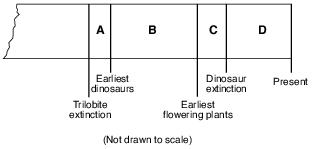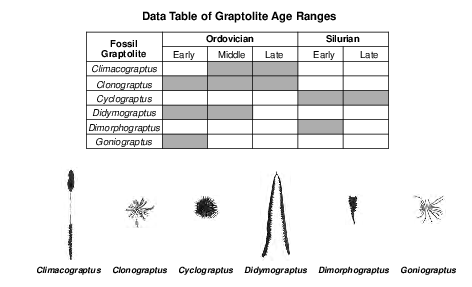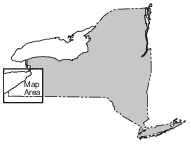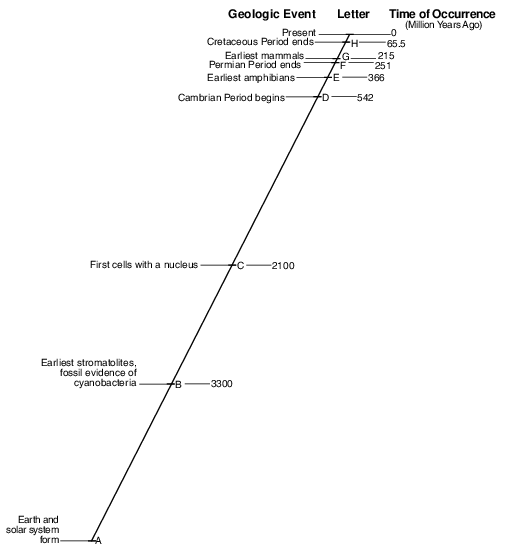Topic: Geologic Time Units And The Events
Geologic Time Units And The Events
The diagram below is a portion of a geologic timeline. Letters A through D represent the time intervals between the labeled events, as estimated by scientists.

Fossil evidence indicates that the earliest birds developed during which time interval?
(1) A
(2) B
(3) C
(4) D
The diagram below represents some fauna (animals) found fossilized in Canada’s Burgess shale.

During which geologic epoch did these animals live?
(1) Middle Cambrian
(2) Early Pennsylvanian
(3) Late Triassic
(4) Paleocene
Which group of organisms survived mass extinctions that marked the ends of both the Paleozoic Era and the Mesozoic Era?
(1) ammonoids
(2) graptolites
(3) eurypterids
(4) gastropods
Graptolite Fossils
Although graptolite fossils are found in bedrock from the Cambrian Period into the Pennsylvanian Period, their remains are most abundant in Ordovician and Silurian rock layers. During their existence on Earth, graptolites evolved quickly and spread widely due to ocean circulation. These tiny and fragile fossils are usually found in dark shales that formed in marine environments. They are rare in sandstones or other rocks that formed near shore.

Which graptolite from the data table would best serve as an Early Ordovician index fossil?
(1) Climacograptus
(2) Clonograptus
(3) Didymograptus
(4) Goniograptus
Geologic history is divided into eras, periods, and epochs based on the
(1) type of rock deposited at different times throughout history
(2) half-life of radioactive isotopes found in rocks
(3) inferred movements of Earth’s landmasses
(4) fossil evidence found in bedrock
During which period in geologic history did the uplifting of the Adirondack Mountains begin?
(1) Quaternary
(2) Cretaceous
(3) Triassic
(4) Cambrian
During which geologic epoch do scientists infer that the earliest grasses first appeared on Earth?
(1) Holocene
(2) Pleistocene
(3) Oligocene
(4) Eocene
Waimea Canyon
Waimea Canyon is located on the west side of the island of Kauai, Hawaii. Waimea Canyon has been referred to as the “Grand Canyon of the Pacific.” But unlike the Grand Canyon, which was carved through horizontal layers of sedimentary rocks, Waimea Canyon was cut through basalt. The formation of this igneous rock began about 4 million years ago. Numerous lava flows followed as magma rose from deep within Earth. The canyon then was formed over time by erosional agents, causing deep, V-shaped valleys that exposed the basalt layers along the canyon walls.
Over time, the composition of the basalt, where it was exposed at the surface, was changed due to oxidation (rusting) of iron-bearing minerals, such as pyroxene and olivine. The result is a canyon with red rocks and soils.
Identify the epoch during which the first basalt lava flows occurred on Kauai. [1]
Epoch
Allow 1 credit for Pliocene Epoch.
On the timeline in the image below, accurately shade in an area to represent the entire Permian Period. [1]

Allow 1 credit for a shaded bar that begins and ends within or is touching the clear rectangles shown below.
• 
•
• Note: It is recommended that an overlay of the same scale as the student answer sheet be used
• to ensure reliability in rating.
Frozen Mammoth
A wooly mammoth was found in 1999 buried in the frozen soil of the Siberian tundra. Carbon-14 dating indicated that it had died about 20,000 years ago. Many fossils represent only the partial remains of organisms. However, a complete mammoth with bones, skin, hair, and internal organs intact represented a unique opportunity for scientists to investigate the lifestyle of this animal and the environment in which it lived.
Identify both the period and epoch of geologic time during which the wooly mammoth lived. [1]
Period
Epoch
Allow 1 credit if both responses are correct: Quaternary Period and Pleistocene Epoch.


Map II shows the course of the Allegheny River during a specific part of a geologic time period. State the name of this geologic time period. [1]
Period
Allow 1 credit for Quaternary Period.

Identify the geologic eon during which event letter B occurred. [1]
Allow 1 credit for Precambrian or Archean.

Fossils of the first multicellular, soft-bodied marine organisms were found in rock unit D. Identify the eon that indicates the geologic age of this rock unit. [1]
Eon
Allow 1 credit for Precambrian Eon or Proterozoic Eon.
• Note: Do not allow credit for “Late Proterozoic” or “Late Precambrian” because these are eras,
• not eons.

Identify the geologic time period in which the extensive coal-forming forests represented in diagram A were most abundant. [1]
Period
Allow 1 credit for Carboniferous or Pennsylvanian Period.
• Note: Do not allow credit for “Early Pennsylvanian” or “Late Pennsylvanian” because these terms
• denote epochs not periods.
Dinosaur Skull Offers Hints About Africa’s Past
A fossil skull was found in Africa among many dinosaur bones from the Late Cretaceous Epoch. This skull came from a dinosaur named Rugops primus, or “first wrinkle face.” This meat eater, believed to have been about 30 feet long and to have lived 95 million years ago, belonged to a group of dinosaurs called abelisaurids.
This fossil skull, unearthed in the Sahara Desert in 2000, provides new evidence that Africa split from other southern continents at a later time than previously thought. Before this discovery, abelisaurids from that period had been found only in South America, Madagascar, and India, but not in Africa. This new fossil, Rugops primus, found only in Africa, indicates that Africa was still connected to the other southern landmasses, at least by a land bridge, 100 million years ago.
During which geologic era is Rugops primus inferred to have lived? [1]
Era
Allow 1 credit for Mesozoic Era.
